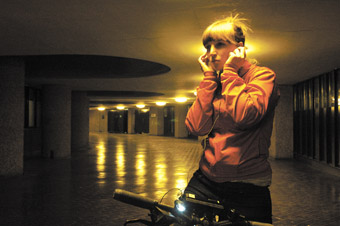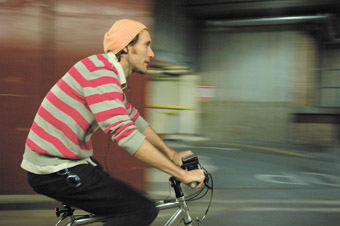mixed reality cycling
gabriella giannachi ‘performs’ blast theory’s rider spoke in london

Rider Spoke, Blast Theory
BLAST THEORY’S LATEST WORK RIDER SPOKE CONSISTS OF A HIGHLY ORIGINAL AND EXCITING FORM OF AUGMENTED TRAVEL. THE PIECE’S STRUCTURE IS DECEPTIVELY SIMPLE. PARTICIPANTS ARRIVE AT A VENUE WHERE THEY CAN SWAP CREDIT CARD DETAILS FOR A HANDHELD COMPUTER (NOKIA N800), MICROPHONE AND HEADSET, BICYCLE AND HELMET, ALLOWING THEM TO CYCLE FREELY WITHIN ANY KIND OF URBAN SETTING, BEFORE AND AFTER LISTENING TO OTHER PARTICIPANTS’ STORIES AND RECORDING THEIR OWN FOR FUTURE LISTENERS. THE PIECE CAN LAST FOR UP TO ONE HOUR.
The computer, which is attached to the handlebar, functions as a positioning system. Yet instead of showing the cyclist’s location on a standard map, it utilises an interface combining images from Mexican votive painting, sailor tattoos and heraldry. Aided by the interface, the cyclist navigates an expanded city, made of intimate, sometimes delicate, occasionally passionate and even hilarious author-generated content.
Rider Spoke was developed in 2007 by Blast Theory in collaboration with the Mixed Reality Laboratory at Nottingham University, Fraunhofer Institute and Sony Net Services as part of IPerG, a four-year research project funded by the European Commission’s IST Programme, whose principal objective is an investigation of pervasive games which interweave digital media with participants’ everyday lives. Another outcome of this project is Blast Theory’s Day of the Figurines (2006-current; RT80, p6), also developed with the Mixed Reality Laboratory, winner of an honorary mention at Prix Ars Electronica 2007.
I ‘performed’ Rider Spoke in London, at the Barbican Centre. The operators, wearing colourful checked shirts, took my details. Outside, a bicycle had been prepared by Matt Adams, one of Blast Theory’s founding members. I was told to be careful and to wait for the device to contact me, which it did, some 10 minutes later, as I cycled down a busy road. The first message appeared on the screen: “Find somewhere you like, then give yourself a name and describe yourself.” I was then invited to find a hiding place to record my answer. I remember that I turned right and right again, away from the traffic. At that point, I was neither lost nor worried but strangely euphoric, caught between the liberating act of cycling and the equally liberating possibility of confessing to strangers.

Rider Spoke, Blast Theory
A swallow, a clear iconographic reference to the possibility of regeneration, representing the migrating soul in Egyptian art and the resurrection in Christian art, appeared on my screen. This, I had been told, indicated that I could stop. The contrast between the evocative image on the console and my surroundings couldn’t be starker. I remember seeing a run-down council estate on the left and an empty pavement on the right, near a couple of boarded up shops. Some children were playing football. “Describe yourself”—I wondered what that meant. Usually, in these kinds of performances we are encouraged to create a role, but here I felt that the role would be even more minimal than in Blast Theory’s previous works. Aware that one day there might be listeners, I started to record a description of ‘myself’, surrounded by strangers, looking at me looking at them.
Once I completed my message, I cycled on, noticing, perhaps more intently than otherwise, passersby, taxis, buses, queues of impatient, tired looking people going places. I, of course, wasn’t really going anywhere. Although I was travelling, and following the console’s directions, as well as paying attention to overall traffic, there seemed no purpose to my travel. Actual places, my own memories, distant voices of absent others became intertwined. I still remember the fragments that made my route: a bustling local pub, a Chinese woman carrying a mountain of washing, a young, elegant man on his mobile dropping a piece of paper, the sound of a familiar voice (Martin Flintham’s, from the Mixed Reality Laboratory) that made me smile, a police car coming too close, a broken window, a deserted bus stop where I recorded my message, a hole on the road, my bicycle tipping to the right. I also remember listening through the headset to the tempting but somewhat sad recorded voice of another Blast Theory founding member, Ju Row Farr, who, by alerting us to the work’s rules, was also taking us backward and forward in time. And there was the image of the swallow appearing on the interface when I least expected it, alluding to the possibility of worlds beyond.
Rider Spoke offers binary choices—either to pause or move; either to speak or listen. These frictions, breaking up the fluidity of everyday life, allow for contaminations between present and past, actual and digital, geographical and fictional. I listened to Martin’s story. The surrounding setting became a backdrop to something other that had neither happened there nor then. I cycled on. I recorded another story, about a wild teenage party, and then one more about someone who keeps me awake at night. I still recall listening to the private, introspective stories that somehow rendered other participants present to me. Interestingly, to listen to their confessions, we had to locate their hiding places by cycling until the screen told us we had ‘found’ one. I recall feeling the stark contrast between the cartoon-like prefabricated houses on the screen and the culturally loaded side streets I was in. I remember thinking, so Martin stood in this place and said these words, ‘here.’ The site, the semiotics of both actual and digital locations, then, for a flickering moment, became Martin.
Blast Theory claim that Rider Spoke continues their work on how “new communication technologies are creating new social spaces.” Here, the creation of a publicly authored space (in the sense that it is authored both by the public and in public) takes ‘place’ in realtime. The piece utilises WIFI hotspots able to locate participants in the city so that each ‘hiding space’ functions as a palimpsest, combining two properties: the physical and electronic location. The only evidence of the presence of others here is in space: identities come to coincide with spaces, and spaces with their WIFI fingerprints. As the work progresses, this publicly authored space becomes increasingly complex—not only a fixed geographical map but also a transitory work in progress which, recalling the motion of Walter Benjamin’s Angel of History, pushes participants into the future whilst invariably forcing them to look back at the cumulating debris of their past.
Rider Spoke is a delicate, almost intangible work. Like other Blast Theory performances, it combines elements of trust and risk, irony and politics, confession and exposure, orientation and disorientation, everyday life and digital worlds. But whereas Day of the Figurines lasted weeks, here we are able to navigate through the work for barely one hour. Unlike Can You See Me Now? or Uncle Roy All Around You, there is no mission, no background scenario, no overarching narrative. Rather, this piece exposes a tension between our presence in space and our being in time. Whereas temporally, by asking us to remember, Rider Spoke relocates us in the past, spatially, by encouraging us to cycle forwards, it asks us to project ourselves into the future. Our ‘here and now’ then, our present, is at stake both literally, in the busy London traffic, and ontologically. Catching its participants as they move between the real and the digital, past and present, role-play and self-consciousness, motion and stasis, this fascinating piece marks a new phase in Blast Theory’s work. Here, unlike previous performances, the city is no longer somewhere to chase or find others but rather a depository of voices and their ephemeral memories. As an archive, or palimpsest, the city becomes an aging skin—a place of imprints, tattoos, scars of presence realised by recording or replaying the memories of our past whilst rapidly moving into an uncertain future.
RealTime issue #83 Feb-March 2008 pg. 26






